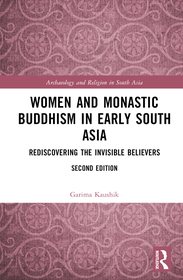
Women and Monastic Buddhism in Early South Asia
Rediscovering the Invisible Believers
Sorozatcím: Archaeology and Religion in South Asia;
-
10% KEDVEZMÉNY?
- A kedvezmény csak az 'Értesítés a kedvenc témákról' hírlevelünk címzettjeinek rendeléseire érvényes.
- Kiadói listaár GBP 125.00
-
59 718 Ft (56 875 Ft + 5% áfa)
Az ár azért becsült, mert a rendelés pillanatában nem lehet pontosan tudni, hogy a beérkezéskor milyen lesz a forint árfolyama az adott termék eredeti devizájához képest. Ha a forint romlana, kissé többet, ha javulna, kissé kevesebbet kell majd fizetnie.
- Kedvezmény(ek) 10% (cc. 5 972 Ft off)
- Kedvezményes ár 53 747 Ft (51 188 Ft + 5% áfa)
Iratkozzon fel most és részesüljön kedvezőbb árainkból!
Feliratkozom
59 718 Ft

Beszerezhetőség
Még nem jelent meg, de rendelhető. A megjelenéstől számított néhány héten belül megérkezik.
Why don't you give exact delivery time?
A beszerzés időigényét az eddigi tapasztalatokra alapozva adjuk meg. Azért becsült, mert a terméket külföldről hozzuk be, így a kiadó kiszolgálásának pillanatnyi gyorsaságától is függ. A megadottnál gyorsabb és lassabb szállítás is elképzelhető, de mindent megteszünk, hogy Ön a lehető leghamarabb jusson hozzá a termékhez.
A termék adatai:
- Kiadás sorszáma 2
- Kiadó Routledge India
- Megjelenés dátuma 2025. december 18.
- ISBN 9781032156187
- Kötéstípus Keménykötés
- Terjedelem296 oldal
- Méret 234x156 mm
- Nyelv angol
- Illusztrációk 41 Illustrations, black & white; 23 Halftones, black & white; 18 Line drawings, black & white; 11 Tables, black & white 700
Kategóriák
Rövid leírás:
This book presents gender as a framework to offer unique insights into the sociocultural foundations of Buddhism. It highlights the multiple roles played by women as patrons, practitioners, lay and monastic members and the like within Buddhism.
TöbbHosszú leírás:
This book presents gender as a framework to offer unique insights into the sociocultural foundations of Buddhism. Moving away from dominant discourses that discuss women as a single monolithic, homogenous category – thus rendering them invisible within the broader religious discourse – this monograph examines their sustained role in the larger context of South Asian Buddhism and reaffirms their agency. It highlights the multiple roles played by women as patrons, practitioners, lay and monastic members and the like within Buddhism. The volume also investigates the individual experiences of the members, and their equations and relationships at different levels – with the Samgha at large with their own respective Bhik&&&351;u or Bhik&&&351;un&&&299; Samgha, with the laity, and with members of the same gender (both lay and monastic). It rereads, reconfigures, and reassesses historical data in order to arrive at a new understanding of Buddhism and the social matrix within which it developed and flourished.
This new edition draws on recent archaeological data from ancient Buddhist sites in Sri Lanka and recently compiled ethnographic data from convents in Spiti valley in Himachal Pradesh, India. It assesses if the working model formulated for the identification of gendered structures at sites in India holds good for sites across South Asia and highlights the presence of women within the monastic circles in varied roles.
Bringing together archaeological, epigraphic, art historical, literary as well as ethnographic data, this volume will be of interest to researchers and scholars of Buddhism, gender studies, ancient Indian history, religion, and South Asian studies.
TöbbTartalomjegyzék:
List of Map and Figures. List of Plates. Acknowledgements. Preface. List of diacritical marks. Abbreviations. Introduction. 1. Sacred Spaces and the Feminine in Buddhism 2. Locating the Bhiksuni: Identifying Nunneries 3. Exploring Women’s Space: Conflict between The Social and the Asocial Worlds 4. Women as Patrons 5. Gendered Survey of Buddhist sites in Sri Lanka. Conclusion. Bibliography. Index
Több




